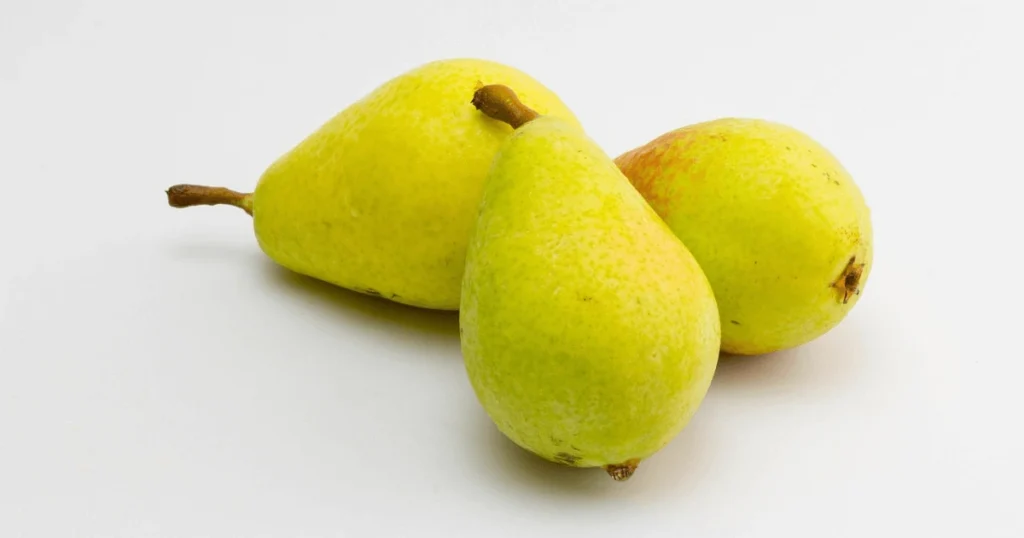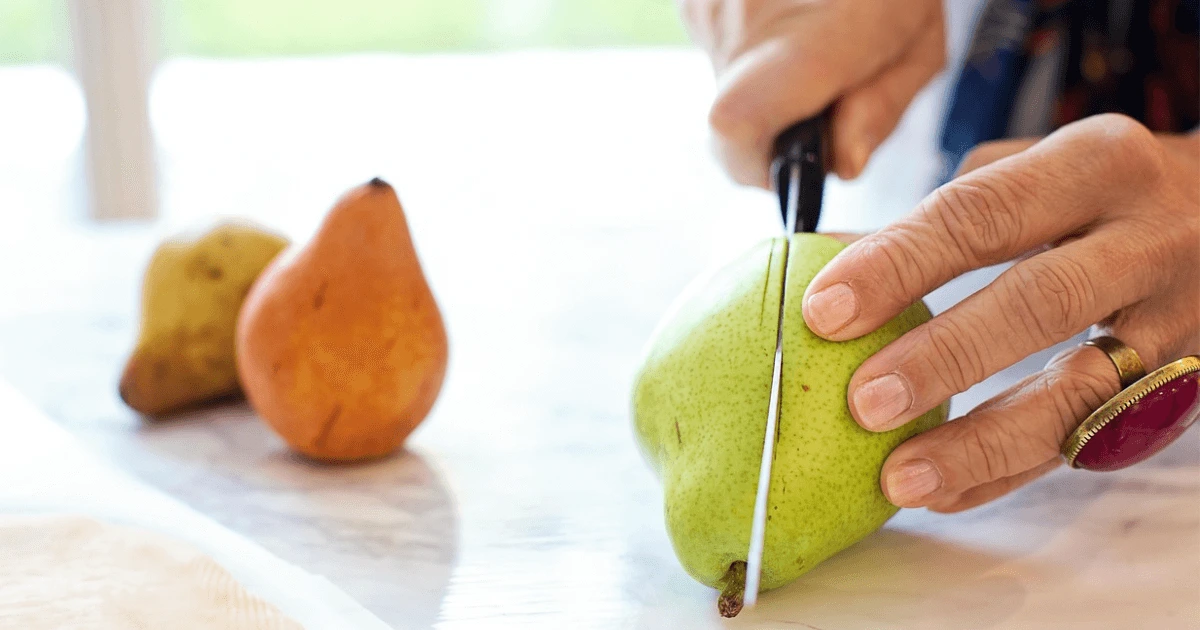Can Dogs Eat Pears? 7 Vet-Approved Tips for Safe & Healthy Snacking
Table of Contents
Introduction
Curious if you can share a slice of pear with your pup? You’re not alone — many dog owners wonder whether this juicy fruit is a safe snack for their furry friends.
The short answer? Yes, dogs can eat pears. But before you toss your pooch a bite, there are a few things you should know. From the right type of pear to serving size and safety tips, this guide dives into everything you need to know about feeding pears to dogs.
We’ll break down the health benefits, risks, and even explore questions like:
- Can dogs eat Korean pears?
- Can dogs eat pears with skin?
- And what about Asian pears?
Let’s get to the core of it. 🍐🐾
Are Pears Safe for Dogs?
Yes — pears are generally safe for dogs when served properly and in moderation. These sweet fruits are loaded with vitamins, fiber, and antioxidants that can support your dog’s health.
But here’s the twist: not all parts of the pear are dog-friendly, and too much of this treat can lead to tummy troubles. The seeds contain trace amounts of cyanide, the core can pose a choking hazard, and the natural sugars in pears — while not toxic — can be too much if overfed.
Health Benefits of Pears for Dogs
So, why bother sharing pears with your dog at all? Turns out, these juicy fruits aren’t just tasty — they come packed with perks that can support your dog’s health:
- Rich in Vitamins: Pears are a natural source of vitamin C, which supports immune function, and vitamin K, which plays a role in healthy blood clotting and strong bones.
- Digestive Boost: Thanks to their high fiber content, pears can help regulate your dog’s digestion and support a healthy gut.
- Antioxidant Power: Pears contain antioxidants that help fight oxidative stress and keep your pup’s cells in top shape.
- Essential Minerals: With potassium for heart health and copper for red blood cell production, pears offer more than just sweetness.
- Hydration Helper: Their high water content makes pears a refreshing way to keep your dog hydrated, especially on warm days.
Pears aren’t the only fruits dogs can enjoy — check out our full guide to vegetables and fruits for dogs for more healthy options.
Whether you’re feeding a sliver of a Bartlett or wondering “can dogs eat Korean pears?” — the nutritional profile remains similar. Just be sure you’re feeding the fruit right, which brings us to the next point.
How to Safely Feed Pears to Dogs

Can dogs eat pears? Yes — but how you serve them makes all the difference. Here’s how to make pear time both safe and enjoyable.
- Remove the Seeds, Core, and Stem: These parts contain small amounts of cyanide and can be a serious choking hazard. Always cut them out completely before sharing.
- Stick to Fresh, Ripe Pears: Whether you’re slicing up a classic Anjou or curious if your dog can eat Asian pear — ripe is best. Avoid canned pears entirely, as they’re loaded with sugar and preservatives.
- Cut into Small Pieces: Dice or slice pears into small, manageable chunks to prevent choking — especially for small breeds or eager eaters.
- Feed in Moderation: Pears contain natural sugars, so overfeeding can lead to an upset stomach or unwanted weight gain. Limit treats like this to no more than 10% of your dog’s daily calorie intake.
- Wash the Skin Thoroughly: Wondering “can dogs eat pears with skin?” Yes — as long as it’s washed well to remove pesticides. If in doubt, peel it.
- Introduce Slowly: Every dog is different. Start with a small amount and monitor for any signs of allergies or digestive issues like gas or diarrhea.
When served properly, pears — even varieties like Korean or Asian pears — can be a safe, tasty treat your dog will love.
Risks and Warnings
Even though pears are generally safe, there are a few important red flags to be aware of when feeding them to your dog:
🚫 Never Feed the Core or Seeds
Pear seeds and the woody core contain trace amounts of cyanide, which can be toxic in large quantities. The core also poses a serious choking hazard, especially for smaller dogs.
🚫 Avoid Canned or Preserved Pears
Wondering if canned fruit is an easier option? It’s not. Canned pears are a no-go — they often contain added sugars, syrups, and preservatives that can cause stomach upset, weight gain, or even long-term health issues.
⚠️ Too Much of a Good Thing
Pears may be healthy, but overfeeding — especially if your dog isn’t used to fruit — can lead to:
- Diarrhea
- Gas and bloating
- Weight gain (from natural sugars)
Stick to moderation. One or two small slices for a medium-sized dog is plenty.
⚠️ Allergic Reactions (Rare, but Possible)
While uncommon, some dogs may be sensitive or allergic to pears. If it’s your dog’s first time trying the fruit, start small and watch for signs like:
- Itching or skin irritation
- Vomiting or loose stool
- Excessive licking or paw chewing
⚠️ Texture Matters
Even though dogs can eat Korean pears and Asian pears, these varieties are crunchier and firmer than others — making it even more important to slice them into small, manageable bites.
Fun & Creative Ways to Feed Pears to Dogs

Plain pear slices? Sure, that works — but if you want to spice things up for your furry friend, try these pup-approved ideas for serving pears in a safe, fun way:
🧊 Frozen Pear Bites
Chop up fresh, ripe pear (no seeds or core!), and pop the pieces into the freezer. Serve them as cooling treats during hot days — perfect for dogs who love crunch.
🥣 Mashed Into Their Meal
Got a picky eater? Add a spoonful of mashed pear to their regular dog food for a fruity flavor boost. Just make sure you’re using plain pear only — no sugar, spices, or syrup.
🍓 DIY Dog Smoothie
Blend pear with other dog-safe fruits like bananas or blueberries and a splash of water or plain yogurt for a refreshing smoothie. Serve it as a lickable treat or freeze it in silicone molds for paw-shaped snacks.
🎁 Stuff a Kong or Toy
Mix a bit of mashed pear with dog-safe peanut butter or plain Greek yogurt, then stuff it into a Kong or similar toy. Freeze it for a longer-lasting challenge.
These fun ideas work great whether you’re using Bartlett, Anjou, or wondering “can dogs eat Korean pears or Asian pears?” — just keep portions small and serve it fresh.
Quick Reference Table
Need a fast check on what’s safe? This handy table has you covered:
| Pear Type | Safe for Dogs? | Notes |
|---|---|---|
| Fresh, ripe pear | ✅ Yes (in moderation) | Remove seeds/core, cut into small pieces |
| Pear skin | ✅ Yes | Wash thoroughly to remove pesticides |
| Canned or preserved pears | ❌ No | High in sugar and preservatives — avoid entirely |
| Pear seeds/core/stem | ❌ No | Contains cyanide, choking hazard |
| Korean pears | ✅ Yes | Crunchier texture — cut into small, safe chunks |
| Asian pears | ✅ Yes | Also safe when peeled, chopped, and deseeded |
Frequently Asked Questions (FAQs)
Can dogs eat pears with skin?
Yes, dogs can eat pears with the skin — as long as it’s washed thoroughly to remove any pesticides. If your dog has a sensitive stomach, try peeling the pear first and see how they react.
Can dogs eat Korean pears?
Absolutely. Korean pears are safe for dogs when fed in moderation, peeled or washed, and cut into small pieces. Just like with other varieties, be sure to remove the seeds and core.
Can dogs eat Asian pears?
Yes, dogs can eat Asian pears, also known as Nashi pears. They’re sweet, crunchy, and hydrating — just remember to chop them into bite-sized chunks to avoid choking risks.
How much pear can I give my dog?
Start small — one or two slices for medium to large dogs is enough. Treats like pear should make up no more than 10% of your dog’s daily calories.
Can puppies eat pears?
Puppies can have pears in very small amounts, but their digestive systems are more sensitive. Always consult your vet before introducing any fruit to a puppy’s diet.
9. Conclusion: Should You Give Your Dog Pears?
Yes — dogs can eat pears, and they can even enjoy Korean and Asian varieties too. When served properly, this sweet fruit is a healthy, hydrating treat that delivers vitamins, fiber, and antioxidants.
Just remember the golden rules:
- No seeds, core, or canned pears
- Always wash or peel
- Feed in small amounts
So go ahead, let your pup enjoy a juicy slice — just keep it safe, smart, and in moderation. And as always, when in doubt, check with your vet.

